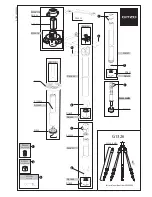
FLIR Camera Adjustments
102-PS242-100-01
Rev110
June 2014
Page 13 of 28
Figure 12: Plateau: 250, ITT: 127, Max Gain: 25
Figure 13: Low contrast scene: high gain
Figure 14: Plateau: 250, ITT: 127, Max Gain: 50
Figure 15: Low Contrast Scene: very high gain
The plateau equalization algorithm performs a non-linear transformation from 14-bit to 8-bit based on
image histogram. It is a variant of classic histogram equalization, an algorithm that maps 14-bit to 8-bit
using the cumulative histogram of the 14-bit image as the mapping function. In classic histogram
equalization, an image comprised of 60% sky will devote 60% of the available 8-bit shades to the sky,
leaving only 40% for the remainder of the image. Plateau equalization limits the maximum number of
gray shades devoted to any particular portion of the scene by clipping the histogram (via the plateau
value) and limiting the maximum slope of the mapping function (via the maximum gain value). It also
provides an ITT midpoint value that allows mean brightness of the 8-bit image to be specified. The Tau
2.7 release includes the ability to allot a linear portion to the histogram (via Smart Scene Optimization),
include an irradiance dependent contrast adjustment (via Active Contrast Enhancement), and specify
outlier rejection (via Tail Rejection). The description below provides explanations of each of these
parameters.
Lo
ts
of
co
nt
ra
st














































